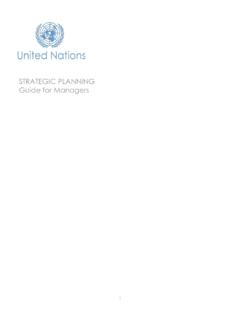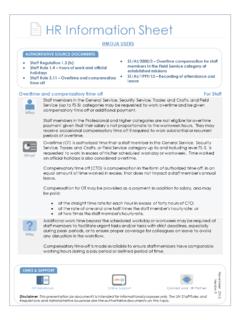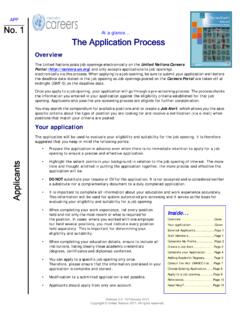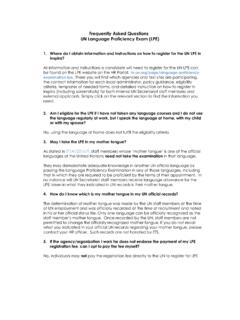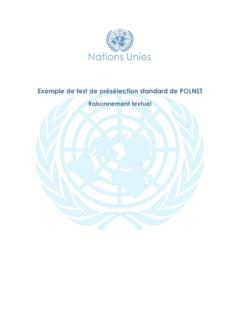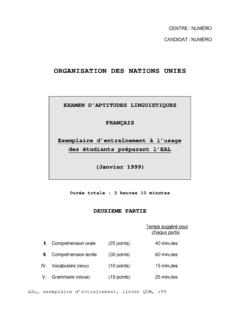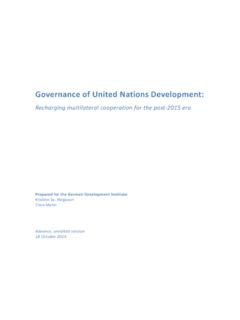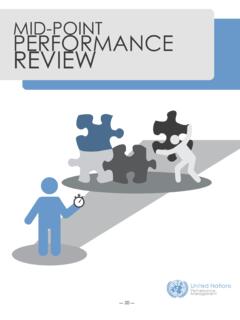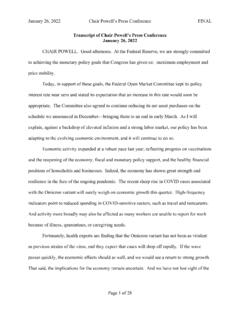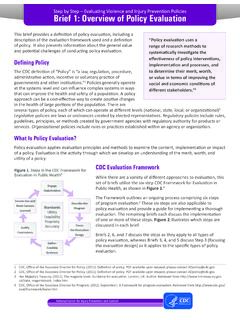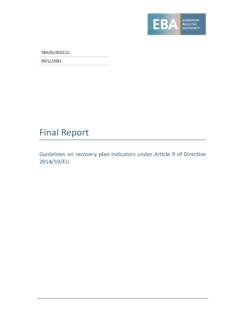Transcription of WORK-PLANNING Guide for Managers - United Nations
1 1 WORK-PLANNING Guide for Managers 2 WORK-PLANNING Guide for Managers In all UN offices, departments and missions, it is critical that Managers develop effective work-plans for their existing programmes and when creating new programmes. Managers use the work-plans to communicate the objectives and strategies to staff members and develop individual agendas of work. Here you will find practical techniques based on global management best practices. WORK-PLANNING defined WORK-PLANNING is the process of determining what an office intends to carry out for the term of a work cycle ( annual or biennial budget calendar). Work-plans should be constructed within the guidance and focus of a strategic plan and should contain the operational details that illustrate exactly what services will be delivered and to what level of quality.
2 Element 1: Work-plan objectives A work-plan should outline the primary objectives of the team. Where there is an overall strategic plan for the office level (or a USG/ASG compact), the overall objectives should be directly derived from the source but only those that apply to the WORK-PLANNING time period. Objectives that apply to a future time period should be omitted. The work-plan should clearly articulate what areas of focus are most important for the upcoming work year or budgetary cycle. How to Determine and Write Organizational Objectives When organizational objectives are clearly outlined in an existing strategic plan, you carry those objectives pertinent for the given year directly from the strategic plan to the work-plan.
3 In other cases, organizational objectives need to be derived from a higher-level relevant work-plan, such as that of the division or larger programme, or region, or project team. In some cases, the management team or a working group will identify a set of objectives that capture the focus for the coming year. Whatever the source, the larger objectives need to be translated to concepts and actions relevant to your target group/unit. In the UN we use the SMART methodology to write objective statements. SMART stands for: Specific target a specific area or change Measurable quantify or at least suggest an indicator of change or progress Achievable specify goals that are reachable Realistic state what results can realistically be achieved, given available resources Time-related specify when the result(s) expect to be achieved Element 2: Core services Your work-plan objectives will clarify the upcoming areas of focus and desired achievement within a given work cycle.
4 How those objectives will be achieved occurs through the delivery of an organization s core services. The work-plan should then clearly outline the core services offered to clients by an office, specifying exactly what will be delivered within the core services for the upcoming year or biennial budget cycle. For each service, articulate the specific focus for the service area. Example: Coordinate aid workers: improve timeliness of deployed staff. 3 Two methods: project-based or process-based Core services are delivered in one of two methods: project-based, whereby an office delivers services via projects with start dates and end dates and with specific deliverables integrated in the project; or process-based, whereby an office delivers services via ongoing work processes that continually operate.
5 Project-based services A project includes a timeline, interim milestones, human resources, budget resources, and specific deliverables. Projects are managed through timeliness, adherence to budget, and the quality of outputs. Within the work-plan, list and describe the key projects and deliverables in the coming budget year. It is not necessary to list every sub-project; instead focus on those that are most significant, which could be by strategic alignment, size of resource investment or relevance to the satisfaction of the office s mandate or clients. How to identify and list core projects The critical details to capture for core projects are as follows: Project Name Project Description Core Service Alignment Start Date End Date Main Milestones/Dates Human Resources (who/how many) Budget Resources (anticipated) Deliverables/Outputs Project Beneficiaries/Clients For each key project, identify the performance measures for how success will be determined.
6 Ideally, a project performance measure captures the level of quality of the deliverable or satisfaction of the beneficiary. Other interim performance measures may include whether the project is on-time, on-budget, and/or on-quality, relative to the original project plan. Process-based services Processes are also often called ongoing activities. As it is a continuous set of activities, a process is best described through identifying the following: Suppliers (those who provide inputs of any kind) Inputs (what it needs to function or acts on) Internal Processes (the steps it goes through) Outputs (what it produces) Clients (those who receive and use the outputs) Describe objectives for the key processes of the office in the coming budget year.
7 It is not necessary to list every task ( making photocopies); instead focus on the most significant core work, which could be by strategic alignment, size of resource investment, or relevance to the office s core mission. How to identify and list core processes Process performance measures captures success as the level of quality of the ongoing service. This can be measured, for example, through client satisfaction; whether services are timely; whether services are delivered within budget; and whether services meet client needs or change criteria. The critical details to capture for key processes are as follows: Process Name 4 Process Description, or description of the element of the process that is the focus of the objective Human Resources (who/how many) Budget Resources (anticipated) Process Outputs or change indicators Process Clients or measures of the satisfaction by the beneficiaries Element 3: Strategic and internal initiatives You may also need to identify strategic initiatives that represent special efforts focused on internal improvement.
8 Initiatives may come directly from a higher-level strategic plan that contains initiatives owned or under the responsibility of the Department or Office that involve every division, section, unit and team in some aspect within the coming year or biennial budget cycle. You may also consider taking up initiatives confined to your management area that are designed to improve internal operating processes, staff capabilities, knowledge management, and financial management. How to document strategic and internal initiatives The critical details to capture are as follows: Initiative Title Initiative Description Objective Alignment (if strategic plan exists) Start Date End Date Main Milestones/Dates Human Resources (who/how many) Budget Resources (anticipated) Deliverables/Outputs Initiative Clients Element 4: Identifying Work-plan Risks Risk management is the identification and mitigation of risks that would hamper the execution and/or expected results of a work-plan.
9 Work-plan risks are categorized in two ways: 1) Possible/known risks from the external operating environment What might happen in the context of the political arena, economics, social issues, technology, the environment/climate, legalities, security/safety, regulations, or other factors present in the location? 2) Possible/known risks in the internal environment What might happen in the context of funding, human capital, processes, projects, service quality and service timeliness? Risks intersect a work-plan in the following two ways: 1) Risks affecting core services Which could prevent the successful execution of key projects? Which could prevent the successful execution of key processes?
10 2) Risks affecting strategic or internal initiatives Which could prevent the successful execution of initiatives? 5 How to develop a risk management approach in WORK-PLANNING 1. Identification: Risks can be identified via surveys, management team brainstorming, the media, or other sources ( expert sources). Risk identification should be an ongoing activity. 2. Prioritization: Rank the risks according to 1) their likelihood of occurring and 2) the potential negative impact on the work-plan. The highest scoring risks should then be clearly identified as either drivers of work-plan objectives, as considerations for key services (projects or processes), or as threats to initiatives.
